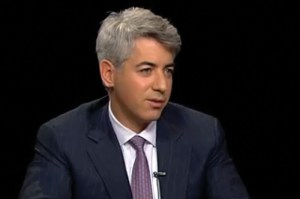
In mid-July, Bill Ackman was relaxing on Nantucket when he got a call on his cell phone. On the other end was Michael Ashner, the CEO of Boston-based Winthrop Realty Trust, who had a plan to grab control of the 11,200-apartment property that occupies a healthy 80-acre chunk of Manhattan’s East Side.
“They contacted me and said, ‘This is an interesting situation; would I be interested in being involved?'” Mr. Ackman, the loquacious, successful hedge fund manager, recalled.
He was.
Now, about three weeks later, Messrs. Ackman and Ashner are mounting an aggressive effort, akin to a hostile corporate takeover, to seize control of the property that was perhaps the real estate boom-turned-bust’s highest-profile failure: Stuyvesant Town and Peter Cooper Village.
The move–announced Monday as Mr. Ackman’s Pershing Square Capital and Winthrop acquired $300 million of a second mortgage and filed a foreclosure motion on the property’s owners–would seem to lend itself to a battle. After all, the holders of the $3 billion first mortgage, which is controlled by the special-servicer firm CW Capital, had been humming along on a foreclosure of their own that would have placed them in control and wiped out any of the other investors, such as Winthrop.
Of course, time will tell whether CW Capital does indeed launch a fight–it has suggested to others it might, given that it was upset with Mr. Ackman and Winthrop’s move–or whether it amicably sits down and works something out with the opportunistic investors.
The nondescript red-brick apartment buildings, originally built for the middle class, are quickly becoming the site of a big-name skirmish once again. ‘That’s a lot of testosterone fighting over this,’ said one person involved in discussions with many of the parties.
Regardless, the move injects some new drama into the colossal property’s narrative, as it will either be taken over by a hedge funder (who just bought the behemoth retailer General Growth Properties in a similar fashion), or there will be a fight to push him out.
More and more, it seems that high-profile names fighting for control will be the legacy of Stuy Town. For its historic sale in 2006, most every big name in New York real estate–not to mention finance–lined up to try to buy the property, all of which would have overpaid by today’s numbers.
And now, between Mr. Ackman, Fortress Investment Group (which just agreed to buy CW Capital) and suitors such as landlord Richard Lefrak who are raptly watching from the outside, the nondescript red-brick apartment buildings, originally built for the middle-class, are quickly becoming the site of a big-name skirmish once again.
“That’s a lot of testosterone fighting over this,” said one person involved in discussions with some of the parties.
A FEW QUESTIONS emerge from this: Why? Given that it’s filled with drab buildings and far away from the traditional high-value battlefields of midtown–what’s the gigantic allure? And given that there’s always an attraction to Stuy Town that defies rationality, won’t new owners always overpay when it inevitably trades hands again?
Mr. Ackman, for his part, simply says he’s motivated by the value of the deal. He and Winthrop paid just $45 million for the $300 million in debt, and now have the potential to grab the rest of the property, which has $3 billion in first-mortgage debt. “I think it’s worth a lot more than $3 billion,” he told The Observer in a phone interview on Monday. “We can sell units to tenants at much lower than market prices and still make enough money to pay off the first mortgage and still make profit for us.”
This latest chapter all started when Winthrop looked around for options after the owners, a partnership led by Tishman Speyer, defaulted on their debt at the start of the year.
Winthrop had put in $25 million to get a senior piece of the second “mezzanine” mortgage. The firm then sought out the other holders of the $300 million top layer of that mortgage and managed to put together agreements to buy, at a steep discount, the debt, which would then give it the ability to foreclose on the owners.
Enter Mr. Ackman. The investor put up much of the money; the two firms formed a partnership (77.5 percent Pershing Square; 22.5 percent Winthrop), and, on Sunday, they slipped a foreclosure notice–which escaped wide notice–in The New York Times business section. (The city’s biggest office landlord, SL Green, which holds junior mezzanine debt, had been part of the deal, but appears to have dropped out, according to people familiar with the talks.)
Now the partnership has set up meetings with tenant leaders–who are a powerful political force that might be able to be brought on board with a co-op conversion plan–and others involved. As for the tenants, Winthrop and Mr. Ackman seem to acknowledge that if a co-op conversion were to be successful, the residents would have to be on board.
“It’s a $3 billion real estate transaction,” Mr. Ackman said. “They need help. They need us, we need them. I think that’s the right way to look at it, and there’s plenty of room to make a deal where everyone’s happy.”
WHETHER THINGS GO well with CW Capital will probably be evident in a matter of weeks. Mr. Ashner and Mr. Ackman have scheduled Aug. 25 as the date when they will grab effective ownership of Stuy Town, if no subordinate investors or others, CW Capital included, raise hell. And CW Capital, in turn, would need to give a month’s notice to itself foreclose on the property.
Still, Winthrop and Pershing have a sword to fight back with against CW Capital, should they need it. If they are able to seize control, they could quickly throw the property into bankruptcy and avert the CW Capital-led foreclosure.
That is not what Mr. Ackman and company would rather do.
“We believe our plan will provide maximum value for all classes of bondholders,” said Carolyn Tiffany, president of Winthrop, “and we look forward to working cooperatively with CW Capital if at all possible.”
ebrown@observer.com


